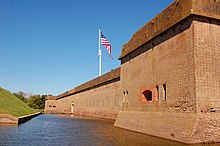Fort Pulaski was prepared for a possible infantry attack. However, Fort Pulaski never endured a direct land assault. With 36 guns, including the new James Rifled Cannon and Parrott rifles, Union troops began a long sustained bombardment of Fort Pulaski. The rifled projectiles could be accurately fired farther (4–5 miles) than the larger and heavier smoothbore cannonballs. Within 30 hours, the new rifled cannon had breached one of the fort's corner walls. Shells now passed through the fort dangerously close to the Fort's main powder magazine. Reluctantly, Colonel Olmstead surrendered the fort. Only one Confederate soldier and one Union soldier were injured in the attack.
Within six weeks of the surrender, Union forces repaired the Fort and all shipping in and out of Savannah ceased. The loss of Savannah as a viable Confederate port crippled the Southern war effort. With the Fort securely in Union control, General David Hunter, commander of the Union garrison issued General Order Number Eleven, which stated that all slaves in Florida, Georgia, and South Carolina were now free. President Abraham Lincoln quickly rescinded the order, but later issued his own Emancipation Proclamation in 1863. At this time, Fort Pulaski was made a final destination on the Underground Railroad as slaves throughout the area were freed upon arrival on Cockspur Island.
The garrison of Union soldiers reached 600 during the initial occupation, but as the War dragged on it became obvious the Southern forces would not be able to retake the Fort. The garrison was later reduced to around 250. Late in the War the Fort would be made into a prison for a group of captured Confederate officers known as "The Immortal Six Hundred." Thirteen of these men would die at the Fort. After the War ended Fort Pulaski continued as a military and political prison for a short while. It would house a Confederate Secretary of State, Secretary of the Treasury, Secretary of War, Assistant Secretary of War as well as three state governors, a senator and the man who had commanded the Fort after it had been taken by the South.
This was the view seen as the confederate soldiers tried in vain to defend their fort. There was never another brick fort built after this defeat.
Pin it!

Purchase here
SOLD
www.CarolSchiffStudio.etsy.com
www.CarolSchiffStudio.blogspot.com






No comments:
Post a Comment